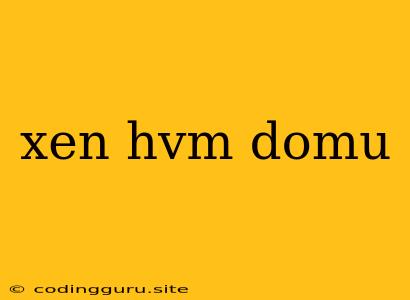Understanding Xen HVM and DomU: A Deeper Dive into Virtualization
Virtualization has become a ubiquitous technology in modern computing, enabling efficient resource utilization and flexible deployment of applications. Among the different virtualization technologies, Xen has established itself as a powerful and widely adopted solution. This article delves into the fundamentals of Xen virtualization, specifically focusing on Xen HVM and DomU, exploring their roles, benefits, and practical applications.
What is Xen?
Xen is a type of hypervisor, often referred to as a virtual machine monitor (VMM), that acts as an intermediary between the underlying hardware and the guest operating systems running on top of it. In simpler terms, Xen creates a virtual environment where multiple operating systems can run simultaneously on a single physical machine.
Xen HVM: Hardware Virtualization at its Core
Xen HVM (Hardware Virtual Machine) is a virtualization technology that allows guest operating systems to run directly on the physical hardware. This is achieved by providing a virtualized environment where the guest operating system interacts with the physical hardware through a layer of abstraction provided by Xen.
Here's how Xen HVM works:
- Direct Hardware Access: Unlike other virtualization techniques, Xen HVM enables guest operating systems to interact with the hardware directly, eliminating the need for emulation or translation. This results in better performance and compatibility, as guest operating systems can leverage the full potential of the underlying hardware.
- Hypervisor Control: Xen HVM acts as a hypervisor, controlling the access and allocation of hardware resources to different guest operating systems. This ensures that resources are shared efficiently among the virtualized guests.
- Paravirtualization: Xen HVM utilizes paravirtualization, a technique where guest operating systems are modified to run directly on the hypervisor. This allows for a more streamlined interaction between the guest operating system and the hypervisor, resulting in improved performance.
DomU: The Guest Operating System in Xen HVM
DomU (Domain User) refers to the guest operating systems that run on top of the Xen HVM hypervisor. DomU is responsible for managing the user applications, user processes, and the overall operation of the guest operating system.
Key characteristics of a DomU:
- Isolated Environment: DomU runs in its own isolated environment, isolated from other DomUs and the hypervisor itself. This provides a secure and protected environment for applications and data.
- Guest Operating System Compatibility: Xen HVM supports various guest operating systems, including Linux, Windows, Solaris, and others.
- Hardware Resource Allocation: DomU receives a dedicated portion of the physical hardware resources, such as CPU, memory, and network interfaces, allocated by the Xen hypervisor.
The Benefits of Xen HVM and DomU
The combination of Xen HVM and DomU offers a range of benefits:
- Enhanced Resource Utilization: Xen HVM enables the consolidation of multiple guest operating systems on a single physical server, maximizing hardware utilization and reducing hardware costs.
- Improved Server Consolidation: Virtualizing multiple operating systems on a single server allows for increased server density and reduces the need for physical servers, ultimately lowering power consumption and space requirements.
- Enhanced Flexibility and Scalability: Virtualization using Xen HVM and DomU provides flexibility in deploying, scaling, and managing virtualized environments. You can easily create, destroy, or modify virtual machines without impacting the underlying hardware.
- Enhanced Security: Xen HVM provides a secure and isolated environment for guest operating systems, reducing the risk of security breaches and ensuring the confidentiality and integrity of data.
Examples of Xen HVM and DomU in Action
Here are some practical examples of how Xen HVM and DomU are used in real-world scenarios:
- Cloud Computing: Xen HVM and DomU are widely used in cloud computing environments to provide virtualized infrastructure for hosting various services and applications.
- Server Virtualization: Xen HVM is a popular choice for virtualizing server environments, allowing businesses to consolidate servers, reduce costs, and improve performance.
- Desktop Virtualization: Xen HVM can be used to create virtual desktops, allowing users to access their desktop environment from any device with a web browser.
Conclusion
Xen HVM and DomU are key components of a powerful and versatile virtualization solution. They offer a robust and efficient method of running multiple operating systems on a single physical machine, providing numerous benefits, including enhanced resource utilization, improved security, and increased flexibility. The use of Xen HVM and DomU is prevalent in diverse applications, contributing significantly to the efficient and secure operation of modern computing environments.
